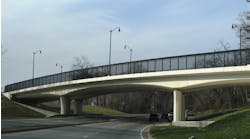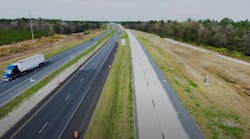The traveling public no longer has the time nor patience to suffer through prolonged and lengthy bridge replacement projects which disrupt traffic patterns for months and sometimes years at a time.
Avoiding such circumstances is exactly what the Iowa Department of Transportation (IDOT) achieved using the accelerated bridge construction method (ABC) on the Little Silver Creek Bridge on Iowa 92 just west of Treynor in Pottawattamie County, Iowa.
ABC technologies and innovations are transforming the way state departments of transportation tackle the Sisyphean task of whittling away at the number of functionally obsolete bridges in their respective states.
Since 2010, IDOT has reduced its number of structurally deficient bridges from 6,796 to 6,205—a 2% dent. This list includes the Little Silver Creek Bridge.
The functionally obsolete structure was already in IDOT’s program to be replaced because of the lack of viable repair options. It would be the second bridge in the state to be replaced using the ABC method. With 5,200 vpd, the busy roadway was well suited for this type of expedited construction.
The main goal for the overhaul of the bridge was improving the ABC modular decked beam method first deployed by IDOT on the U.S. 6 Bridge over Keg Creek in 2011.
Whereas the U.S. 6 over Keg Creek project served as a proof-of-concept for this method of accelerated bridge construction, the Little Silver Creek Bridge project over Iowa 92 was intended to evaluate a broadened application of this technology. A deliberately more challenging site was chosen.
“We wanted to treat this project as a learning experience first and foremost,” Curtis Carter, lead design engineer for the Little Silver Creek project, told Roads & Bridges.
Crews working on one of the three spans of the Little Silver Creek Bridge in Pottawattamie, Iowa.
“The previous ABC job we’d done was in the same county, so we had the same inspection staff, and district engineers were familiar with the type of method we were going to deploy,” Carter said.
The replacement structure consisted of a three-span, 234-ft x 44-ft modular rolled steel beam bridge that utilized roughly 20% cast-in-place concrete construction—the most on-site concrete work IDOT had done for an accelerated construction project. The remaining 80% was done using the precast concrete technique—the hallmark of ABC.
The superstructure was divided into 18 modules, which included a pair of steel beams with a precast concrete deck on top of it. The deck modules had to be precast in concrete before the project even started to allow for rapid construction.
The three spans measured 90 ft 11 in., 91 ft ll in. and 51 ft. Each span required six deck beam modules, with each set measuring the same length as its corresponding span.
The combination of accelerated and non-accelerated construction techniques considerably reduced the length of road closures from six months down to roughly three weeks.
Is it worth the cost?
Using ABC is moderately more expensive, but the ROI of using this method was significant. The agency chose higher cost materials such as stainless steel which would prolong the life of the bridge deck. IDOT also factored the user cost the public would have to pay that a longer construction period would have required.
“With the slightly longer detour and higher volume of traffic, there’s a considerable inconvenience to the people in the community this bridges serves. The value of their time, vehicle mileage and wear and tear offsets some of the taxpayer burden on this bridge. So we understood that could justify some additional upfront construction costs,” Carter said.
Additionally, the project was also able to secure $1 million in incentive funding from the Federal Highway Administration in the form of a grant from the FHWA Accelerated Innovation Deployment Program.
What set it apart
Unlike the first ABC project, the Little Silver Creek Bridge was skewed 20° relative to the roadway in a steep curvature at one end of the bridge and an end that was close to level on the other side.
The pieces that needed to be put into place were all quite variable to fit the vertical curvature and the skew of the bridge. To complete this phase of construction, crews had to build much of the bridge during critical closure periods, using cast-in-place concrete.
“With those geometry constraints it also forced us to build more of the bridge on the critical closure period. With this new bridge being skewed, we didn’t have enough room to build the foundations outside the footprint before the original bridge was closed, so we had a lot more work during the closure,” Carter said.
Contractors were given the option to use cast-in-place concrete construction on all the bridge components except the bridge deck, which was required to be prefabricated off-site in order to shave a chunk of time off the project timeline. They chose to use cast-in-place concrete for the abutments, foundation, barrier rails and approach pavement because it allowed for more room to adjust any errors made during the initial pour.
The concrete mixes played a large role in the project’s success. To improve the durability and resiliency of the bridge, IDOT used a combination high-performance and ultra high-performance concrete (UHPC) to complete the project within a few weeks.
High-performance concrete was used for its superior strength over short distances. IDOT aimed for 50,000 psi for nearly all the cast-in-place concrete and achieved much higher strength with 24-36 hours of cure time, a markedly accelerated pace.
UHPC was used for critical bridge connection details, including the longitudinal joints, and achieved strengths of 20,000 psi within the same curing timeframe as the high-performance concrete also used for the project.
UHPC consists of fine sand, cement, silica fume and quartz flour in a dense, low-water cementitious materials ratio (0.15 to 0.19) mix. Compressive strengths of 18,000-30,000 psi can be achieved depending on the mixing and curing process.
IDOT chose to use a 100% stainless steel reinforced bridge deck for several reasons, the first reason tying back to the original goal of the project—to perfect the application of ABC.
“Iowa is exploring the use of more stainless steel so we wanted to have a few bridge decks out there on our system to see if they’re performing that much better and worth the extra cost,“ Carter said.
In addition, joints tend to be the weakest link of any bridge and stainless steel serves as the best reinforcement for the vulnerable parts of the bridge.
Other materials were considered but stainless steel was the best option for the sandblasting that was needed to create a rough concrete texture.
They also had to opt for a more expensive foundation type because construction called for the largest pile size ever used in the state of Iowa.
A status update
The project, which was completed in November 2015, had a 21-day contract incentive. Crews ended up needing three more days to complete the project largely due to concrete cure times slowing down toward the end of the year as temperatures dropped.
A concrete pour is being performed for deck pre-fabrication.
Corrective grinding also needed to be done on the approach side of the project. Crews had to perform some grade adjusts to tie existing roadway into the new structure, which took a little more time than expected.
“We monitored it with string gages and set up an evaluation program to drive known weight over the bridge just to see how the bridge reacted,” Carter said, “So far every indication says it’s doing what we expect it to.”
The total cost of the project ended up being $3.6 million, between $400,000-$500,000 above the planned cost. However, the time saved and life expectancy added to the bridge using ABC is anticipated to more than make up for that difference. R&B



